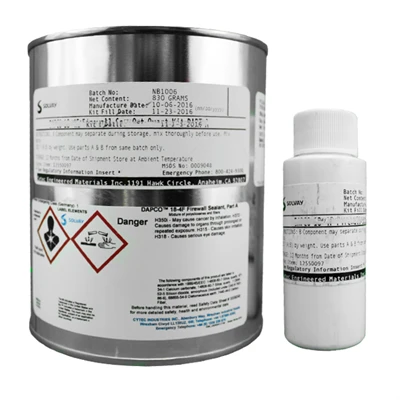Dapco 3300 Silicone Adhesive: Durable Bonding for Aerospace & Defense
Adhesives are an essential part of every aircraft maintenance toolkit, and low-viscosity Rubber, Thermal Vulcanizing (RTV) is one of the most commonly used adhesives across all types of aircraft. It is used on metal, glass, and plastic substrates, and also bonds silicone rubber sheet stock and extrusions.
Let’s take a look at this common but handy adhesive and how Greenwood Aerospace is your #1 supplier of Dapco 3300 Silicon Adhesive.

Introduction to Dapco 3300
Dapco 3300 is a two-part sealant, meaning that it comes as a pack of two separate substances that are mixed prior to use. It is a low-viscosity silicone adhesive specifically designed to work with multiple types of substrates, including metals (of various kinds), glass, and plastics. Dapco 3300 offers rapid development of its physical properties, making it a suitable option for applications that require quick handling of bonded assemblies.
It is designed with aviation in mind to withstand extreme conditions and extreme temperatures. Again, it is purpose-built for both bonding and sealing multiple materials.
Key Properties and Benefits
Dapco 3300 is a popular low-viscosity silicone adhesive used to effectively bond silicone materials. It is a good choice for potting (the process of completely encasing electronic components within silicone sealant to protect them from environmental factors and mechanical stress) and encapsulation.
Dapco 3300 has a seven-day cure time, but it can be accelerated by an overnight gel period, followed by exposure for 4–6 hours at 160°F, as per the Dapco 3300 TDS.
This type of sealant is explicitly made for aerospace and aviation applications. It will withstand extreme temperatures and resist outgassing, making it a suitable option for sensitive electronics.
Product Characteristics
For the full technical characteristics of Dapco 3300, make sure to consult the TDS provided by the manufacturer.
DAPCO 3300 is a two-component, silicone-based sealant primarily used in aerospace applications, especially for sealing access panels and fuselage components. It cures at room temperature and is designed for brush application, offering flexibility and resistance to environmental factors after curing.
Key Properties:
Application: Intended for use as a protective seal on aircraft structures. It’s suitable for sealing gaps and joints, especially where flexibility is needed.
Cure Profile: Cures at room temperature through moisture in the air. The time required to reach a tack-free condition and achieve a complete cure depends on the humidity and temperature conditions.
Performance: After curing, the sealant remains flexible and exhibits good adhesion to common aircraft materials. It withstands environmental stressors such as temperature variation and humidity.
Physical Characteristics: The uncured product has a paste-like consistency and is red in color. Once cured, it forms a resilient and elastic seal.
Application Method: Apply directly by brush or spatula to clean surfaces. No mixing is required due to its one-component nature.
Storage and Handling: The Product should be stored in a cool, dry place and used within the recommended shelf life. Standard safety precautions for handling silicone-based sealants apply.
Additional Notes:
The product conforms to specific aerospace material specifications (AMS, BMS).
It is not intended for structural bonding or load-bearing applications.
Proper surface preparation is essential to ensure performance and adhesion.
Procuring Adhesives from Greenwood Aerospace
Whatever your sealant, adhesive, oil, or other lubricant needs are, Greenwood Aerospace is your preferred partner to get you what you want, when you need it, for a price that fits your budget. We work with top partners to procure our products at the best prices and also keep a lookout for them on GSA Advantage here soon!

.webp)
.svg)





